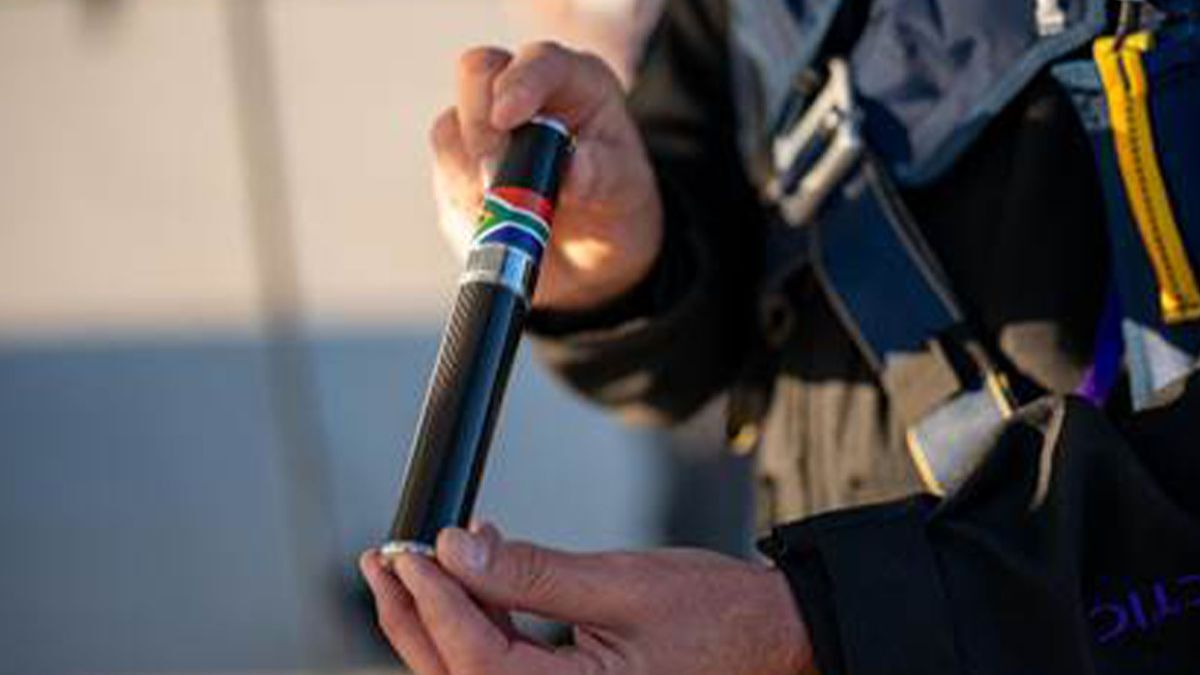Fragmentary remains of two ancient human relatives, Australopithecus sediba and Homo naledi, were carried aboard a Virgin Galactic flight on Sept. 8. Departing from Spaceport America in New Mexico, the fossils, carried by South African-born billionaire Timothy Nash in a cigar-shaped tube, were rocketed to the edge of space.
“I am horrified that they were granted a permit,” Sonia Zakrzewski, a bioarchaeologist at the University of Southampton in the U.K., wrote in an X thread, noting she would use it as an example in her class about unethical approaches. “This is NOT science.”
So yes, despite the misleading title these priceless remains of our shared hominid heritage made it back, safe in the pocket of an arrogant billionaire.
But why even risk it in the first place? There’s absolutely no reward and some risk. That’s dumb.
Moreover, this stunt is part of a disturbing trend of scientifically questionable promotion from Lee Burger, who was already a big name within archeology after finding Sediba and now on his way to wider celebrity since Naledi.
Homo Naledi is incredible in almost every regard - location, dates, preservation, number of individuals, morphology. It’s nuts.
But recently Burger has been doing things like putting out press releases before peer review, timing them to boost his Netflix show. The latest claims of fire, tools and abstract carved symbols ended up failing peer review but were published anyway. They are full of tests not done, obvious hypotheses not considered, specialists not consulted, numbers that didn’t replicate and some weirdly partially obscured images. But he’s still out there, getting his conclusions into the public consciousness when they are not scientifically verified.
Yet another publicity stunt with no scientific merit is sure to piss off archeologists.
Having only recently seen the show, can you point me to more information about Lee Burger? Is there an agenda there beyond trying to make money?
I don’t know anything about agendas.
There’s a lengthy video from Gutsick Gibbon that goes over the peer reviews in detail. History Hit has separate interviews with Burger and professor Chris Stringer. If you search for ‘homo naledi peer review’ you should find some articles.
ITT: people who know nothing about and have no interest in archaeology and paleontology arguing why this doesn’t matter. You guys do know you’ve wandered into an Archaeology thread, right?
Something about South African billionaires just turns brains to mush.
As an archaeologist, this is hilariously shocking. I cannot stop laughing at how ridiculous of a move this is.
Yet another South-African-born billionaire shooting dumb things into space? I thought one was more than enough.
billionaire dick measuring and trophy hunting… what will they not waste merely to say they could…
It was pointless, which is a reason to have not taken them, but they’re back now so it’s kind of a moot point. Just a “don’t do it again” situation.
What’s the problem here? Just some dick taking a bone to space? Am I missing the issue?
What would happen if the ship had blown up? We would have lost those fossils. That’s at least irresponsible.
They’re already lost if some rich fuck owns them
Why does this matter? They’re bones, there’s more of them, and we’ll find more in the future. Even if they were actually lost, I see no problem with this. Just a rich dude being a rich dude.
Who cares?
The archeologists. It says so in the title.
Probably because they would have liked to have been able to study the priceless artifacts, and have them available for future study, and education
I mean it didn’t crash? They are still available.
And potentially altered by having been unnecessarily put through extremely abnormal treatment, meaning any conclusions you draw from studying them are muddied by having been blasted out into space, regardless of having come back.
Folks have brought up that taking them into space exposes them to high levels of radiation, and the proper steps may not have been taken to protect the remains from said radiation. Folks have argued that because they were in a craft, that they won’t have been exposed to any radiation, but thats not how that works- people who take a flight on a regular airplane are exposed to higher levels of radiation, nevermind spacecraft. Taking the remains into space needlessly reduces their value to scientists who may have learned things from them, and now what they learn may not be meaningful or helpful, because the remains were handled so unusually.
It was entirely unnecessary, nothing was gained by having done it, and it has a cost to science, so the scientists are unhappy- that hardly seems surprising.
It was hardly even in space. Sure it was unnessery, but no worse then shipping them somewhere by plane.
The less atmosphere between you and the sun, the more radiation you’ll experience. There was definitely less atmosphere between the remains and the sun in this case than if they were shipped by plane, making the radiation higher.
And if they were shipped somewhere by plane during normal transport by academics, they would have taken the appropriate steps to ensure the preservation of the sample.
I can’t say I really understand why some people seem so surprised that the scientists would be unhappy at this, or feel like they scientists are being unreasonable here. Their whole job is to learn as much as they can from what samples we can recover from the past for the benefit of humanity’s understanding, and a priceless sample was needlessly handled in a way that may make it useless to their studies, because a billionaire though it would be entertaining to shoot it into space for no real reason…
In what world would they not be unhappy with this situation?
The remains, were blasted out into space.
They are not available, they are irretrievably gone.
They couldn’t be more lost to the annuals of time than things thrown in a volcano.
No? They were on a glorified plane that landed back on earth.
edit: “A two-million-year-old collarbone and a 250,000-year-old thumb bone were stored in a protected container and tucked into the pockets of Timothy Nash, one of three paying customers”
So unless they jettisoned this guy, the bones are safe …
https://www.space.com/virgin-galactic-human-fossils-in-space
How is some human remains a “priceless artifact”? That’s the point, besides like 100 people in the world, Noone gives a single shit.
Ok no. They aren’t human remains, they are incredibly ancient ancestors of humans.
Pick out a hobby of yours for a moment. Something you like. Now let’s say that someone found an artifact related to the early days of that hobby. It’s a very rare one, like maybe the Nintendo PlayStation. Something cool that’s worth studying and learning about what could have been.
Now imagine some rich dickhead fucking blasted it to the edge of the fucking universe. Guess what, we can’t fucking learn about it anymore BECAUSE NOTHING CAN MAKE A FICKING ROUND TRIP TO GET IT BACK WITH CURRENT TECHNOLOGY. Anything we could have possibly learned about it. Gone.
And your response is “so what?”
They are back on earth again… I don’t think its a great thing to do, but as long as it’s not harmed its not a problem.
It was dumb to risk something this rare for no reward. That’s a problem.
But even with the remains safe, this is part of a troubling trend from the archeologist in question of seeking publicity and raising the stature of the H. naledi finds (which are legit amazing) beyond what he’s scientifically proven. Don’t blast them into space for a few minutes - show experts the proof for all those claims you continue to make despite failing peer review.
Radioactivity in space alters the remains significantly.
Not so much that it would matter, it was basically a long plane transport. Also its in a metal cylinder so radiation is kept outside…
Not unless it’s lead. Only lead is considered 100% effective against radioaction.
https://www.canadametal.com/what-are-the-various-materials-that-shield-from-radiation/
That can be prevented with metal box techology.
https://www.canadametal.com/what-are-the-various-materials-that-shield-from-radiation/
You mean lead box technology. You can’t use just any random metal unless you want poor results.
The issue is that you can’t guarantee there won’t be harm, and by doing it and not stopping it in the future, you are inviting others to do similar stuff. And probably to one up each other.
And eventually there will be an accident and something important will be lost forever.
Y’all are really out here acting like “no harm no foul” like you’d be fine with your toddler running into the street because “nothing happened!” This time. Next time, a semi could be speeding by.
little trolls only care about themselves
@CookieJarObserver had a bad take but that does not warrant unreasonable harassment.
Plus trying to change someone’s behavior by attacking them instead of adressing the behaviour is an unfortunate path/choice to take as it usually results in the opposite happening where change doesn’t occur and only creates external friction
you need some real life experience… you sound like someone who gets paid a lot to be patient with asshole rich people… like a butler or something…
???
pretty sure I’m the opposite with rich people lol billionaires can get fucked
Read the thread and shut up.
they want attention, too, the little fuckers… ME ME ME…
Get fucked
you are a little twat, every day of your life












